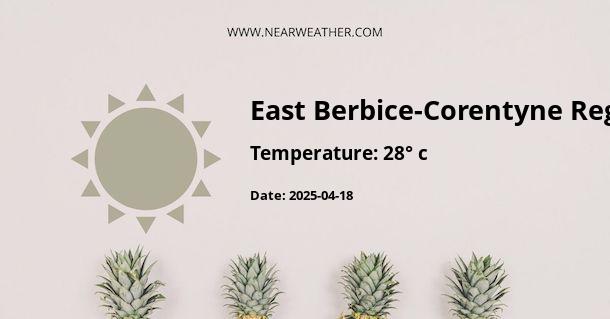East Berbice-Corentyne Region, Guyana: Climate and Weather Overview
The East Berbice-Corentyne Region, located in the northern part of Guyana, is characterized by a tropical climate that is influenced by its proximity to the Atlantic Ocean and the Caribbean Sea. The region experiences distinct wet and dry seasons, and its climate plays a significant role in shaping the local environment and economy.
Annual Climate Overview
The East Berbice-Corentyne Region experiences a tropical rainforest climate, characterized by high temperatures and significant rainfall throughout the year. The region's climate is influenced by the northeast trade winds, which bring moisture from the Atlantic Ocean, resulting in high levels of humidity and precipitation.
The average annual temperature in the region ranges from 24°C to 32°C (75°F to 89.6°F), with minimal variation between the warmest and coolest months. The high humidity levels contribute to the region's tropical feel, making it important for visitors and residents alike to stay hydrated and seek shade when outdoors.
Rainfall Patterns
The East Berbice-Corentyne Region experiences two distinct seasons: a wet season and a dry season. The wet season typically extends from May to mid-August, with a secondary wet period occurring from late November to January. During the wet season, the region receives the majority of its annual rainfall, with heavy downpours and thunderstorms being common occurrences.
Conversely, the dry season, which runs from mid-August to late November and from late January to April, is characterized by significantly reduced rainfall and more stable weather patterns. This drier period is often favored by tourists looking to explore the region's natural beauty and engage in outdoor activities.
Extreme Weather Events
While the East Berbice-Corentyne Region does not experience extreme weather events such as hurricanes or typhoons, it is susceptible to flooding during the wet season. The region's low-lying terrain, combined with the heavy rainfall, can lead to localized flooding, impacting both rural and urban areas. It is essential for residents and authorities to be prepared for potential flood events and to take necessary precautions to mitigate any potential damage.
Impact on Agriculture and Economy
The region's climate plays a crucial role in shaping its agricultural and economic activities. The ample rainfall during the wet season is essential for the cultivation of rice, sugar cane, and other crops that contribute significantly to Guyana's economy. However, excessive rainfall leading to flooding can also pose challenges for agricultural production and infrastructure, impacting the livelihoods of many in the region.
Furthermore, the region's climate and natural resources make it an attractive destination for ecotourism, as visitors are drawn to the lush rainforests, diverse wildlife, and unique ecosystems. Understanding the region's climate patterns is important for both residents and tourists to maximize the potential of the area's natural resources while minimizing environmental impact.
Conclusion
The East Berbice-Corentyne Region's tropical climate shapes its environment, agriculture, and economy. Understanding the region's climate patterns, including temperature ranges, rainfall variations, and potential weather-related challenges, is crucial for residents, businesses, and visitors alike. By being prepared and leveraging the region's natural resources sustainably, the East Berbice-Corentyne Region can continue to thrive in its unique tropical climate.
A - East Berbice-Corentyne Region's Latitude is 4.000000 & Longitude is -58.166672.
A - Weather in East Berbice-Corentyne Region is 28° today.
A - Climate Conditions in East Berbice-Corentyne Region shows overcast clouds today.
A - Humidity in East Berbice-Corentyne Region is 76% today.
A - Wind speed in East Berbice-Corentyne Region is 4.43 km/h, flowing at 19° wind direction. today.
